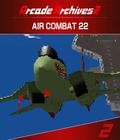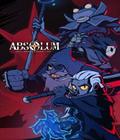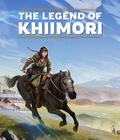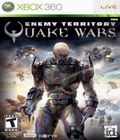Genre: FPS
Publisher: Activision
Developer: id Software/Splash Damage
Release Date: October 2, 2007
Remember the story of the princess and the toad? The gist is that there's a toad (or frog, in some versions), a princess kisses it and it turns into a handsome prince. Inevitably, they live happily ever after. You're probably wondering what exactly this has to do with Enemy Territory: Quake Wars. Well, at first glance, Quake Wars is an ugly toad, but after spending a bit of time with it, it transforms into something quite astonishing.
"Ugly toad" is a little harsh, as the game is far from ugly, but first impressions really aren't immediately gratifying. It seems ridiculously overcomplicated when you begin; the user interface has a nightmarish amount of information overlaid on the screen, and woe betide the new player who chooses Strogg over GDF, as rather than simple classes and weapons like "Engineer" and "Rocket Launcher," you get to try and work out exactly what an Oppressor is and how an Accurized Lacerator works.
Quake Wars is based on Quake 2 and Quake 4. The alien Strogg are invading Earth, and the player takes on a number of missions, whether as Strogg or the human GDF. It's all very Battlefield, with 12 standalone missions clearly intended for multiplayer, but there is fair bot support, and the missions are also linked together across four short campaigns. The major variation from the general Battlefield game is that rather than a "ticket" system and a capture-and-hold series of points set on the map, one team is on offense while the other is on defense. One mission may have three or four objectives — for example, the GDF may have to repair a bridge and defend a slow-moving command vehicle as it moves down the road before disabling a Strogg shield generator, while the Strogg objectives for this mission are to stop the GDF from doing this. On the one hand, it means there's always a clear front of action and players don't have to look around for a fight, but on the other hand, it means that the defenders can't push back as easily. If they do badly in the first five minutes, then they're probably down to their last one or two defense points and will have to tough out the rest of the match.
It sounds simple enough, admittedly: offense/defense teams, with objective-based play and class-based multiplayer. Combinations of these aren't the most common, but most experienced gamers will have seen all of them at one time or another. No, it's in the execution that Quake Wars gets confusing. As soon as you pick a side and a class, you're dumped into the game with a screen full of stats, a radar and HUD full of icons and blobs. It's as confusing as hell at first, and playing against bots is really recommended until you have a decent grasp of what's going on. Fortunately, once you learn a few basics, it doesn't take too long to get accustomed to the rest of the gameplay. Unfortunately, the bots are typical bots: occasionally stupid and frequently difficult to get working as a team. In a team game, that's a bit of a problem. They know what they're doing, but concerted assaults are difficult to organize, and you'll still see the odd one or two constantly driving a tank into a wall. This game is quite clearly designed for multiplayer.
The first important thing to learn is what each class does. There are five classes for each side, and they're roughly equivalent, all falling into the archetypes of the basic soldier, commanders, covert ops, engineers and healers. Importantly, all of them are critical for success. At times it's obvious, as only certain classes can complete certain objectives (covert ops hack things, engineers build things, soldiers plant demolition charges on things, etc.), but each class has myriad uses, partly due to the experience system employed, and partly due to customization. Soldiers can take weapons ranging from assault rifles to rocket launchers, while engineers could opt for shotguns. Covert ops can act as snipers or disguise themselves as the enemy and sneak into guarded locations. Engineers can build turrets, while field ops can call in artillery and air strikes. These abilities allow for various strategies; a personal favorite has been to act as a spotter by disguising as an enemy, and marking troop movements and defensive positions on the map for allies. Experience gained with each class grants additional abilities and weapons, but it's not permanent, so experienced players (atrocious pun intended) don't have a great advantage. The bonuses only carry across campaigns.
Quake Wars really shines when it comes to vehicles. There are a lot, and they show the most variation between the two sides. Both sides have a basic tank, but whereas the GDF have APCs and lightly armored buggies, the Strogg have jetpack equivalents and scout cars. The most amusing vehicle, however, is the Strogg Cyclops — a one-man wrecking machine that walks on two legs and is armed with a gigantic plasma cannon. While all vehicles are useful and powerful, infantry can deal with them if they're careful. Early bias would indicate that the Strogg have an overwhelming vehicular advantage with the highly mobile Icarus (the jetpack vehicle), and the sheer destructive power of the Cyclops, but as you learn to play, they gradually become less threatening than they initially seemed. There's always a way around, even if it involves taking a bike on a detour behind them, or working closely with your team's anti-vehicle troops.
The major feature used to assist new players is the mission system, which allows even the greenest player to benefit his team in some way. Picking a class automatically generates missions for that class, which players can cycle through and complete for points. Medics will automatically have missions to resurrect unconscious soldiers, for instance, while covert ops begin with a mission to deploy a radar. As most beginning players perhaps wouldn't realize that covert ops can do this, it's useful. The mission system is key to the game and is also useful for experienced players; new missions are generated on the fly, depending on what's been spotted by the team.
Of course, none of these useful features are much good if Quake Wars is no fun to play. Thankfully, it is. It varies somewhat based on the team you're in — team play is essential, as at any given time, a solo player is likely to be facing snipers, tanks, bombers and gun turrets, and no single class can easily deal with all three. Playing on a server where your teammates are running around and killing everything they see isn't particularly fun. This doesn't crop up often, fortunately, because kills don't really give points while missions and objectives do, so there's no impetus to go on a random spree.
The main mission objectives are usually based on the specialties of each class and aren't overly varied, but most of the twists come in the style. One mission starts in a desert town but ends in the Antarctic due to teleportation, and while the objectives there remain largely the same, it's a really nice touch that sticks in the mind.
Despite all of this talk of the weapons, one issue I have with Quake Wars is that the weapons generally feel rather light. The GDF rocket launcher and the Strogg equivalent, the Obliterator, both feel weighty and meaty, but most of the other weapons have next to no feeling of destructive power. It's a negative point to any game when a shotgun feels no different from a pistol. It's partly due to the sounds and animation, but mostly because there's no viable feedback from weapons; because it's a multiplayer-centric title, there aren't really any "flinching" animations, and blood is surprisingly sparse. The game feels more clinical than visceral. It's not necessarily a bad thing, but considering the atmosphere is one of hideous cyborg aliens harvesting the population of Earth, it does seem rather out of character.
The levels occasionally fall into the same trap. Some are memorable tooth-and-nail fights for every scrap of ground, but others simply feel like "another desert level," or "another ruined city." With only 12 levels, it's amazing how repetitive some the environments and objectives can be. More levels and more unique objectives would have been nice, but what's here will keep most players occupied for a while.
Enemy Territory: Quake Wars is a solid game, allowing for wildly varying tactics. It's got a steep learning curve, and enjoyment relies as much on having a solid team as it does on the game itself; in many ways, whether you have a very good or very bad game is entirely up to your teammates. As such, while simple pick-up games can occasionally be fun, it's definitely biased toward serious play. If you like Battlefield-style games, then you'll enjoy Quake Wars. Just don't go in expecting to immediately dominate.
Score: 8.4/10
More articles about Enemy Territory: Quake Wars











 Developed by Splash Damage and built on id Software's new MegaTexture rendering technology, Enemy Territory: Quake Wars pits the armies of Earth against the invading alien Strogg in the ultimate online strategic shooter. Featuring strategic team play, persistent character promotions, day and nighttime combat missions, and the universe's most powerful weapons and vehicles, Enemy Territory: Quake Wars transports players to the front lines of an epic new war for Earth.
Developed by Splash Damage and built on id Software's new MegaTexture rendering technology, Enemy Territory: Quake Wars pits the armies of Earth against the invading alien Strogg in the ultimate online strategic shooter. Featuring strategic team play, persistent character promotions, day and nighttime combat missions, and the universe's most powerful weapons and vehicles, Enemy Territory: Quake Wars transports players to the front lines of an epic new war for Earth.














































